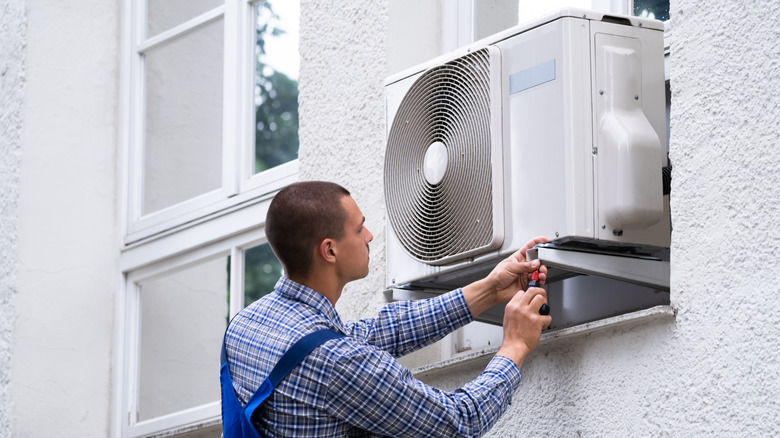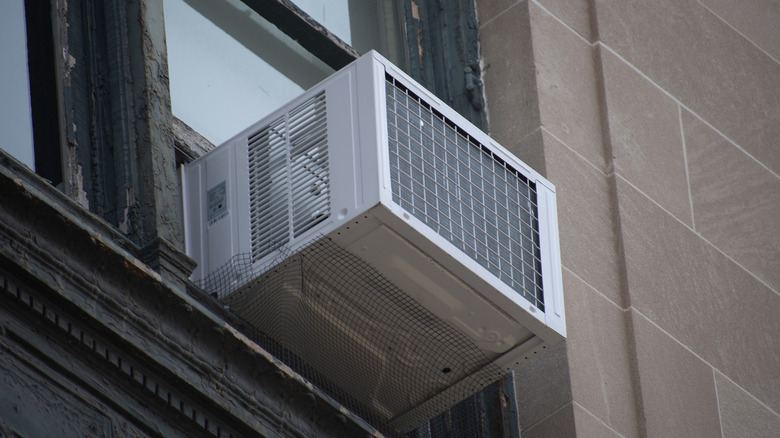How To Easily Install An AC Unit With A Horizontal Sliding Window
We may receive a commission on purchases made from links.
A window air conditioner can be a lifesaver in a heatwave, but how do you install one in a horizontal sliding window? Most window air conditioners are built for hung windows, which slide up and down vertically. In these windows, these units fit snugly into the rather narrow frame, with the bottom sash creating a seal at the top. In contrast, horizontal sliders present a challenge; while the unit will fit easily, there's no glazing above it to create a seal. The good news is that it's possible to install a regular window AC unit if you have horizontal windows, and it's much easier than it sounds. All it takes it a few inexpensive materials and a bit of handiwork.
The key to installing a window AC unit into a sliding window is creating a sturdy base to support the appliance. Another critical task is sealing the empty space on top — unless your windows are the exact size of your air conditioning unit, that is. By leaving this space open, you're inviting insects and burglars into the home, while diluting the conditioned indoor air with outdoor heat. A sheet of plexiglass will help establish a barrier between the outdoors and the home's interior while your window is effectively in an opened state to accommodate the AC. You can use foam board, wooden planks, or acrylic to ensure a snug fit within the window frame and prevent hot air infiltration. Your setup also needs to be completely weatherproof to avoid any water damage to the unit, electrical wiring, or your home.
Giving your AC unit a solid base
First, choose a properly sized window AC unit that will fit width-wise in your window. Then, consider the supports. A horizontal window may not leave you with a windowsill to rest the unit on, so you'll have to fashion a base. Most AC units are sold with a set of brackets that can be installed under the unit, and these can also be utilized on your windows. Start by building a basic platform using plywood and planks, then fasten it to the lower part of your window frame. Use the provided supports or purchase a set of l-shaped brackets to anchor the platform in place. Just ensure that the platform protrudes far enough to carry the full weight of the unit.
Note that the platform should be at a slight downward angle facing away from the house. It might seem counterintuitive, since gravity isn't exactly a friend around windows and heavy objects. But the gentle tilt will allow rainwater to run off the platform, away from the unit and your home. Place the AC on the newly created platform, grabbing an extra pair of hands if you find the unit a bit too heavy. Close the sliding window so that it sits flush against the side of the AC.
Sealing the opening above the AC unit
With the AC unit in place, you'll no doubt notice the glaring opening directly above it. High on the list of do's and dont's when installing a window AC unit is properly covering and insulating this opening. Hot air, bugs, and rainwater can easily find their way into your home if you leave this part of the window open to the outdoors. A quick and effective solution is to use a rigid piece of plexiglass as a stand-in for the upper portion of the glazing. It remains see-through, so it doesn't take away from the design appeal, while protecting your home from the elements at the same time. You can use a few pieces of foam board to insulate the sides of the unit or seal with caulk.
The process of installing the plexiglass is fairly simple. Cut the panel to the exact measurements of your open window. With a piece of removable weatherstripping or silicone sealant, seal the edges of the plexiglass to the side of the window frame. At this point, if you notice that the unit doesn't fit snugly into the assembly, or there are gaps, you can seal the latter with the weatherstripping and caulk. In some cases, you might have to shift the platform a bit to create a better fit for the unit.
Safety considerations to account for when installing the AC unit
Since you're installing a heavy object in a window, you must consider a few safety implications. First, make sure that the unit is stable on the platform you've built. If it isn't, adjust the support platform or the unit until you're satisfied with the stability. If you're concerned that the platform alone may not be strong enough to support the AC, or you just want some peace of mind, install an additional exterior bracket support that attaches to the side of your home and prevents any shifting or tipping during high winds or a severe rainstorm. Likewise, consider inserting either a metal rod or a wooden plank horizontally at the top of the AC, so that it fits into the lip (the lip is meant to accommodate the window sash in a hung window) and both sides of the window frame. This extra support will reinforce the appliance and make it that much harder to dislodge.
Another safety factor to consider is the plexiglass panel itself, especially if you live on the ground floor. The material isn't known for durability and can be easily forced open. A simple window lock or a sliding bar can help prevent the window from being pushed in, ensuring the safety of the unit and your home. If you're renting and can't drill a hole into the window frame, tension-based window bars, like these Droutti Window Security Bars, are your next best bet. Frequently check the outlet and the unit's plug for damage, since faulty electrical components can create a safety hazard. With your appliance now safely installed, learn how to keep the window air conditioner from smelling.


